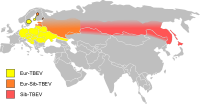
Photo from wikipedia
Dear Editor, A recent report1 has documented the link between fatal encephalitis and infection by Borna Disease Virus-1 (BoDV-1, speciesMammalian 1 orthobornavirus). To date, however, all reported cases originated from… Click to show full abstract
Dear Editor, A recent report1 has documented the link between fatal encephalitis and infection by Borna Disease Virus-1 (BoDV-1, speciesMammalian 1 orthobornavirus). To date, however, all reported cases originated from a geographical area (Germany, Austria and Switzerland) where BoDV-1 is endemic in its animal reservoir, the bicolored white-toothed shrew (Crocidura leucodon).2 Cases have been supposedly linked to zoonotic and/or iatrogenic infections of either immunosuppressed or healthy individuals, although the epidemiology of humanbornavirus encephalitis remains ill-defined. Notably, the question of whether similar cases could also occur in other geographical areas remains open, including in regions where the virus epidemiology has not been studied. Here, we report two probable cases of unspecified bornavirus encephalitis/encephalopathy (as defined in Ref. [1]) in two French transplant recipient patients living in the same geographical area (Tarbes, France). These two patients (see details in Table 1; full disclosure of clinical picture and treatment are available upon request) were kidney-transplant recipients who developed meningo-encephalitis with rhombencephalitis of unknown etiology. Bacterial, viral, parasitological, and fungal agents were looked for in the blood and CSF and all classical infectious causes were ruled out. In view of the recent alerts concerning severe encephalitis due to BoDV-1,1,3–6 we decided to test both patients for the presence of BoDV-1-reactive antibodies. Screening of serum samples was performed by immunofluorescence assays (IFA), using BoDV-1 infected Vero cells (ATCC CCL-81, BoDV-1 He/80 strain), which were cocultured with uninfected Vero cells stably expressing the red fluorescent mCherry protein, to discriminate them from the infected ones and serve as a negative control for staining. Serum samples of the two patients were positive and displayed the classical dot-like pattern that we always observe upon BoDV-1 staining, which corresponds to staining of BoDV-1 “viral factories” in infected cells.7 Fluorescent signals were lost when samples were preadsorbed using amixture of recombinant BoDV-1N and P proteins. Interestingly, a serumsample frompatient #1obtainedbefore the graft was also tested positive, whereas a sample from the organ donor was negative. Other controls included five sera from transplant recipients matched for age, treatment and clinical conditions, but who did not develop any neurological disease andwere all negative. To confirm our IFA results, we performed Western blot analysis, using a mixture of recombinant BoDV-1 N and P proteins (Figure 1). Consistent with results from Eisermann et al.,1 positive signals were obtained mainly for the detection of BoDV-1 P recombinant protein, using samples from both patients. All other assays using control samples were negative. We could also obtain a meningeal biopsy from patient #2, which was embedded in paraffin for histology. Immunohistochemistry using a polyclonal antibody recognizing BoDV-1 P protein revealed a positive staining (mostly nuclear) in this sample. We also observed a positive staining, albeit at lower levels, using a polyclonal antibody recognizing BoDV-1 N protein. Importantly, staining was lost when the primary antibodies were omitted, or when they were replaced by a control isotype. Unfortunately, we could not obtain CNS material from
Journal Title: Transplant Infectious Disease
Year Published: 2021
Link to full text (if available)
Share on Social Media: Sign Up to like & get
recommendations!